Physical Address
304 North Cardinal St.
Dorchester Center, MA 02124
Failure of a primary total hip arthroplasty (THA) typically occurs with varying degrees of femoral bone loss.
Classifying femoral bone defects is a critical part of the preoperative planning required for a successful revision THA. Paprosky, the American Academy of Orthopaedic Surgeons, Endo-Klink, Mallory, Saleh et al., Engh and Glassman, Gustillo and Pasternak, and Chandler and Penenberg have all published classification systems that differ in their complexity and descriptive terms. However, there remains no consensus as to which classification system should be used when assessing bone loss in the face of revision THA. Presently, the Paprosky classification is the most commonly used system.
Femoral bone loss can be extensive, making it difficult to obtain adequate support of the femoral component at the time of revision surgery. As a result, these bone defects can adversely affect the long-term fixation and survival rate of the revised femoral implant.
A classification system for femoral bone loss associated with a failed THA should be both reliable and valid. Reliability refers to both the interobserver reliability, the agreement between different observers and intraobserver reliability, and the reproducibility of the system when one observer looks at a particular case on separate occasions. Validity indicates the accuracy with which the classification system describes the true pathology.
Failure of a primary total hip arthroplasty (THA) typically occurs with varying degrees of femoral bone loss. This bone loss can be the result of osteolysis, mechanical loosening, infection, or stress shielding. Regardless of the underlying cause, femoral bone loss can be extensive, making it difficult to obtain adequate support of the femoral component at the time of revision surgery. As a result, these bone defects can adversely affect the long-term fixation and survival rate of the revised femoral implant.
Classifying femoral bone defects is a critical part of the preoperative planning required for a successful revision THA. A classification system that estimates the pattern and degree of bone loss can aid the surgeon in determining the operative plan. The classification system can predict the complexity of the operation, avoid unanticipated intraoperative findings, and provide an algorithmic approach to the reconstruction of the femoral deficiency in revision THA. This is necessary to determine which implants, instruments, and bone graft will need to be available at the time of revision surgery. Because there are various reconstructive options available to revise a failed femoral component, a classification system also allows the uniform comparison of published outcomes of these different reconstructive techniques.
Several classification systems for femoral bone loss associated with a failed THA have been described in the literature. Paprosky, Mallory, Saleh et al., Engh et al., Gustillo and Pasternak, and Chandler and Penenberg have all published classification systems that differ in their complexity and descriptive terms. The emphasis of the different classification systems varies with the objective that each was designed to achieve. A comprehensive classification system for femoral deficiencies in revision THA was developed by the American Academy of Orthopaedic Surgeons Committee on the Hip and reported by D'Antonio et al. Unfortunately, many of the present classification systems are difficult to remember and/or are inadequate in providing an algorithm for femoral reconstruction. As a result, there remains no consensus as to classification system that should be used when assessing bone loss in the face of revision THA. Presently, the Paprosky classification is the most commonly used system to classify bone defects in femoral revision. The purpose of this chapter is to review the most common classification systems of bone defects associated with femoral revision and, when possible, to link the classification system with the treatment options for femoral reconstruction at the time of revision THA.
To classify femoral defects, it is imperative to have adequate plain radiographs of the failed hip arthroplasty. Anteroposterior (AP) pelvis radiographs—as well as AP and lateral views of the femur that include both the distal end of the failed implant and the femoral isthmus—are essential.
The Paprosky classification for femoral bone loss is a common system in North America and Europe. It attempts to group the failed femur into one of four types based on (1) the location of femoral bone loss (metaphyseal or diaphyseal), (2) degree of remaining support of the proximal femur (degree of cancellous bone loss), (c) and the amount of isthmus remaining for diaphyseal fixation ( Table 97.1 ). This classification system is based on the ability of the reconstruction to bypass the compromised proximal femur and obtain osseointegration of an extensively coated femoral implant in the femoral diaphysis. In addition to classifying femoral defects, this system provides an algorithmic approach to the reconstruction of femoral deficiency in revision THA.
| Type | Femoral Bone Deficiency |
|---|---|
| I | Minimal loss of the metaphyseal cancellous bone with an intact femoral diaphysis |
| II | Extensive loss of metaphyseal bone with a completely intact femoral diaphysis |
| IIIA | Femoral metaphysis is severely damaged and nonsupportive, but there is at least 4 cm of intact cortical bone in femoral diaphysis, |
| IIIB | Severely damaged metaphysis that is nonsupportive and the intact diaphyseal cortical bone is less than 4 cm in length |
| IV | Extensive metaphyseal and diaphyseal damage in conjunction with a widened femoral canal |
In a type I defect, there is minimal loss of the metaphyseal cancellous bone with an intact femoral diaphysis. This type of bone defect is not common. It is usually seen with a failed cementless, smooth implant, such as a failed Austin-Moore prosthesis (Braun, Sheffield, UK; Fig. 97.1 ), or failure of ingrowth for a proximally coated cementless stem. Revision THA is relatively straightforward—the intact metaphyseal bone allows the use of either a cemented or cementless femoral implant. A proximally porous-coated femoral stem is the reconstruction option of choice. Proximal fitting modular stems or extensively porous-coated stems may also be used, depending on surgeon preference. If a cemented stem is used for the revision operation, careful canal preparation and removal of the neocortex and membrane is mandatory to achieve cement interdigitation and long-term success.
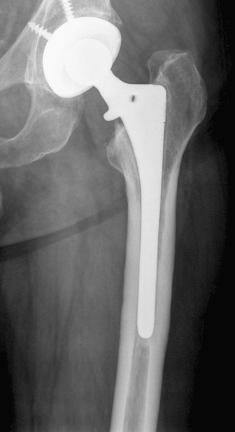
Type II defects are among the more common type of deficiencies. In a type II defect, there is extensive loss of metaphyseal bone with a completely intact femoral diaphysis. This type of defect is often present after the removal of a loose cemented femoral component or in the early stage of loosening of a cementless femoral implant ( Fig. 97.2 ). The deficient metaphyseal cancellous bone precludes revision with a cemented stem. Because the metaphysis remains somewhat supportive, a proximally porous-coated cementless implant with diaphyseal stabilization or either an extensively porous-coated implant with distal fixation or a titanium fluted tapered stem can be used to revise the failed THA. Distal fixation is more commonly used because it can be difficult to determine intraoperatively if the metaphysis is sufficiently supportive. In these cases, the shortest diaphyseal engaging stem that will contact 4 cm of intact isthmic bone can be used. Another popular option for type II defects is the use of a stem with a modular metaphyseal sleeve and distal splines. Type II defects can be associated with varus remodeling of the proximal femur. In these cases, an extended trochanteric osteotomy and a diaphyseal filling implant is required.
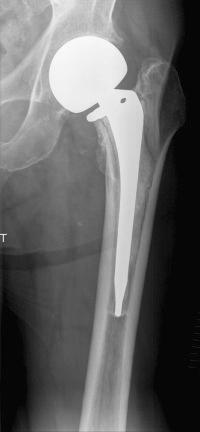
Type III defects are subdivided depending on the amount of intact diaphyseal bone available for distal fixation. In type IIIA defects, the femoral metaphysis is severely damaged and nonsupportive, but there is at least 4 cm of intact cortical bone in the femoral diaphysis ( Fig. 97.3 ). At least 4 cm of intact diaphyseal bone is required to have sufficient implant-cortical contact to achieve initial stability and long-term osseointegration. In these defects, diaphyseal engaging stems, such as cylindrical cobalt chrome and titanium fluted tapered stems, have demonstrated excellent long-term results. However, concerns over stress shielding, intraoperative fracture, and thigh pain have led most revision surgeons to use titanium fluted tapered stems in these cases. In cases with a femoral canal diameter greater than 18 mm, monoblack fully porous-coated cylindrical stems have shown higher rates of failure; thus consideration for another treatment option, such as a titanium fluted tapered stem, should be considered. Another reconstructive technique for type IIIA defects is impaction grafting. Type IIIA defects can be associated with torsional remodeling of the proximal femur into retroversion. In these cases, a modular tapered fluted stem can be used because it allows independent filling of the proximal and distal portions of the femur while allowing independent rotation of the two segments to correct the femoral anteversion. Type IIIA defects are frequently associated with varus femoral remodeling that requires an extended trochanteric osteotomy at the time of revision surgery to ensure proper implant alignment and restoration of the normal femoral alignment ( Fig. 97.4 ).
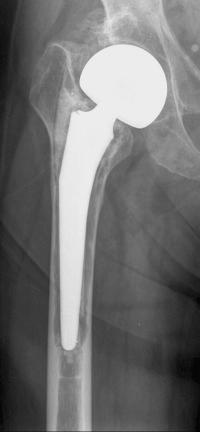
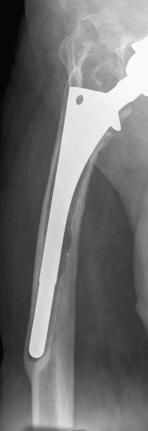
Like type IIIA defects, type IIIB defects have a severely damaged metaphysis that is nonsupportive. However, in type IIIB defects, the intact diaphyseal cortical bone is less than 4 cm in length ( Fig. 97.5 ). This type of femoral bone deficiency is commonly seen with revision of a failed long cemented stem with a distal plug and a long cement mantle or with cementless stems with substantial distal osteolysis. The short region of intact cortical bone in type IIIB defects does not tend to provide sufficient initial scratch fit and implant-bone contact to ensure implant stability and ingrowth. As a result, the use of extensively porous-coated stems in these defects has been associated with an unacceptably higher rate of fibrous stable fixation rather than bone ingrowth. Revision with a modular or nonmodular, titanium fluted tapered cementless stem is recommended for these defects. The tapered and fluted stem is able to obtain excellent initial axial and rotational stability in the face of a very short region of intact isthmus. This design allows the tapered femoral component to wedge into the remaining isthmus, with the flutes providing rotational stability. Modularity allows the impaction of the distal component until it is stable and then provides the ability to build up the proximal segment to restore leg lengths and offset. In general, these fluted tapered stems can obtain predictable fixation with as little as 2 cm of diaphyseal bone contact. Impaction grafting also can be used to reconstruct type IIIB defects if the metaphysis is relatively intact with contained defects or, if not, it can be reconstructed with mesh, strut grafts, or plates.
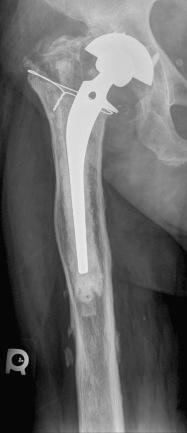
In a type IV defect, there is extensive metaphyseal and diaphyseal damage in conjunction with a widened femoral canal. In these rare cases, the isthmus is nonsupportive and distal fixation cannot be achieved ( Fig. 97.6 ). Revision with a titanium modular fluted tapered cementless stem has demonstrated early and promising results for these defects. In cases in which the proximal femoral cortex is intact, there is significant osteolysis or stress shielding so that the femoral canal is enlarged, with a so-called stove pipe appearance (> 18 mm in diameter) and the length of the intact diaphysis is inadequate to achieve an interference fit for a cementless implant; impaction grafting can also be used to reconstruct the femur and restore bone stock. When the proximal femoral cortex is deficient, a femoral allograft-prosthesis composite can be used to reconstitute bone stock in younger patients, whereas a proximal femoral replacement can be used in older patients.
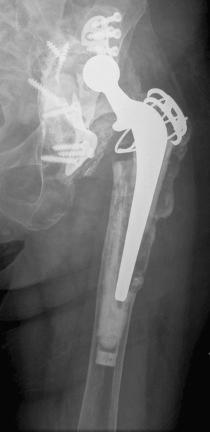
Become a Clinical Tree membership for Full access and enjoy Unlimited articles
If you are a member. Log in here